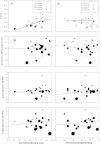Virulence of recurrent infestations with Borrelia-infected ticks in a Borrelia-amplifying bird
- PMID: 26553505
- PMCID: PMC4639849
- DOI: 10.1038/srep16150
Virulence of recurrent infestations with Borrelia-infected ticks in a Borrelia-amplifying bird
Abstract
Lyme disease cases caused by Borrelia burgdorferi s.l. bacteria is increasing steadily in Europe, in part due to the expansion of the vector, Ixodes ricinus. Wild reservoir hosts are typically recurrently infested. Understanding the impact of these cumulative parasite exposures on the host's health is, therefore, central to predict the distribution of tick populations and their pathogens. Here, we have experimentally investigated the symptoms of disease caused by recurrent infestations in a common songbird (Parus major). Birds were exposed three times in succession to ticks collected in a Borrelia endemic area. Health and immune measures were analyzed in order to investigate changes in response to tick infestation and Borrelia infection rate. Nitric oxide levels increased with the Borrelia infection rate, but this effect was increasingly counteracted by mounting tick infestation rates. Tick infestations equally reduced haematocrit during each cycle. But birds overcompensated in their response to tick feeding, having higher haematocrit values during tick-free periods depending on the number of ticks they had been previously exposed to. Body condition showed a similar overshooting response in function of the severity of the Borrelia infection. The observed overcompensation increases the bird's energetic needs, which may result in an increase in transmission events.
Figures



Similar articles
-
Role of mustelids in the life-cycle of ixodid ticks and transmission cycles of four tick-borne pathogens.Parasit Vectors. 2018 Nov 20;11(1):600. doi: 10.1186/s13071-018-3126-8. Parasit Vectors. 2018. PMID: 30458847 Free PMC article.
-
Transmission dynamics of Borrelia burgdorferi s.l. in a bird tick community.Environ Microbiol. 2013 Feb;15(2):663-73. doi: 10.1111/1462-2920.12059. Epub 2012 Dec 23. Environ Microbiol. 2013. PMID: 23279105
-
Patterns of tick infestation and their Borrelia burgdorferi s.l. infection in wild birds in Portugal.Ticks Tick Borne Dis. 2015 Sep;6(6):743-50. doi: 10.1016/j.ttbdis.2015.06.010. Epub 2015 Jun 29. Ticks Tick Borne Dis. 2015. PMID: 26159798
-
The role of Ixodes scapularis, Borrelia burgdorferi and wildlife hosts in Lyme disease prevalence: A quantitative review.Ticks Tick Borne Dis. 2018 Jul;9(5):1103-1114. doi: 10.1016/j.ttbdis.2018.04.006. Epub 2018 Apr 16. Ticks Tick Borne Dis. 2018. PMID: 29680260 Review.
-
[Ixodes ricinus, transmitted diseases and reservoirs].Parassitologia. 2004 Jun;46(1-2):119-22. Parassitologia. 2004. PMID: 15305699 Review. Italian.
Cited by
-
Nest-type associated microclimatic conditions as potential drivers of ectoparasite infestations in African penguin nests.Parasitol Res. 2020 Nov;119(11):3603-3616. doi: 10.1007/s00436-020-06895-x. Epub 2020 Sep 30. Parasitol Res. 2020. PMID: 32996052
-
Determinants of vector-borne avian pathogen occurrence in a mosaic of habitat fragmentation in California.Parasit Vectors. 2025 Mar 15;18(1):110. doi: 10.1186/s13071-025-06742-x. Parasit Vectors. 2025. PMID: 40089710 Free PMC article.
-
The Infection Rate of Bird-Feeding Ixodes ricinus Ticks with Borrelia garinii and B. valaisiana Varies with Host Haemosporidian Infection Status.Microorganisms. 2022 Dec 25;11(1):60. doi: 10.3390/microorganisms11010060. Microorganisms. 2022. PMID: 36677352 Free PMC article.
-
Ineffective humoral anti-tick IgY-response in birds: reaction against pathogen constituents?Open Res Eur. 2021 Sep 23;1:8. doi: 10.12688/openreseurope.13204.2. eCollection 2021. Open Res Eur. 2021. PMID: 37645189 Free PMC article.
-
Host tropism determination by convergent evolution of immunological evasion in the Lyme disease system.PLoS Pathog. 2021 Jul 29;17(7):e1009801. doi: 10.1371/journal.ppat.1009801. eCollection 2021 Jul. PLoS Pathog. 2021. PMID: 34324600 Free PMC article.
References
-
- Read A. F. & Harvey P. H. The evolution of virulence. Nature 362, 500–501 (1993). - PubMed
-
- Wakelin D. Immunity to Parasites. 2nd edn, (Cambridge University Press, 1996).
-
- Hart B. L. in Host-parasite evolution: general principles and avian models (eds Clayton D. H. & Moore J.) 59–77 (Oxford University Press, 1997).
-
- Barbour A. G. & Fish D. The biological and social phenomenon of Lyme disease. Science 260, 1610–1616 (1993). - PubMed
-
- Atkinson C. T., Dusek R. J., Woods K. L. & Iko W. M. Pathogenicity of avian malaria in experimentally-infected Hawaii Amakihi. J. Wildlife Dis. 36, 197–204 (2000). - PubMed
Publication types
MeSH terms
Substances
LinkOut - more resources
Full Text Sources
Other Literature Sources

